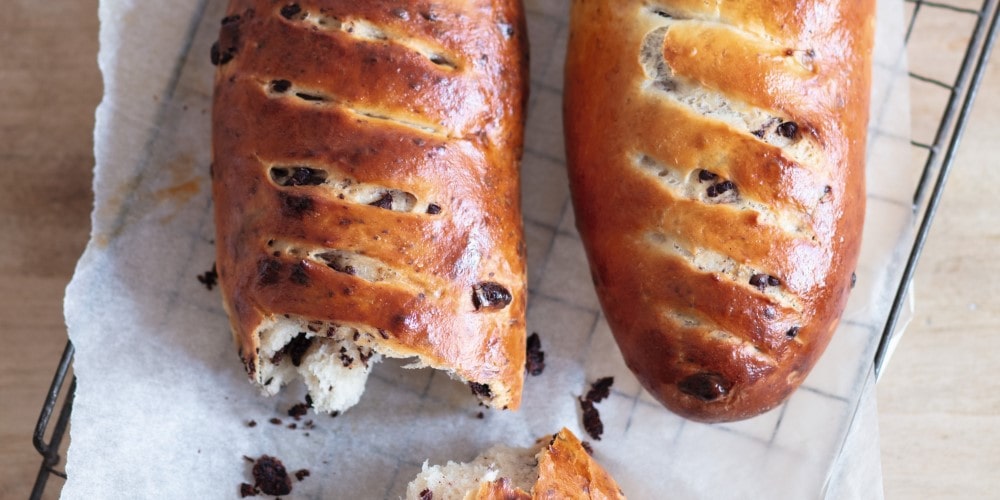
Vienna bread with chocolate chips
Makes: 2 small baguettes
Vienna bread is an enriched, slightly sweet French bread. It can be make plain or in this case with chocolate chips to yield Viennoise au Chocolat! What a delicious way to start the day!
Ingredients
- ⅔ cup (5.25 oz./150 g) whole milk
- 0.25 oz. (7 g) fresh yeast
- 1.75 oz. (50 g) refreshed levain
- 1 generous tbsp (15 g) sugar
- 2 cups (9 oz./250 g) bread flour (T65)
- 1 tsp (0.2 oz./5 g) salt
- 3 tbsp (1.5 oz./40 g) butter, diced, at room temperature
- Generous ½ cup (3.5 oz./100 g) chocolate chips, or 1 (3.5-oz./100-g) chocolate bar, roughly chopped
- 1 egg yolk, lightly beaten
Directions
1Pour the milk into the bowl of a stand mixer fitted with the dough hook. Crumble in the fresh yeast and stir or swish to dissolve, then stir in the levain. Add the sugar, flour, and salt. Knead for 10 minutes on speed 1, followed by 5–10 minutes on speed 2, until the dough pulls away from the sides of the bowl. About halfway through the 5–10 minutes, add the butter with the mixer running. Add the chocolate chips and knead briefly until evenly distributed.
2Shape the dough into a ball, place it in a lightly oiled or flour-dusted bowl, and cover. Let rise for 1 hour in a place that is warm, but not warm enough to melt the chocolate (bulk fermentation*).
3Turn the dough out onto a floured work surface and divide it into two equal pieces. Cover with a towel and let rest for 15 minutes (resting*).
4Shape each piece of dough into a short baguette and place seam-side down on a baking sheet lined with parchment paper.
5Brush the dough with a thin layer of egg yolk, then chill in the refrigerator for 10 minutes to firm it up a bit. Brush with another layer of egg yolk and score with kitchen shears, making several parallel diagonal cuts across the top of the dough.
6Let rise in a warm place for 1–1½ hours (proofing*).
7Toward the end of the rising time, place a rack in the center of the oven and place another rack directly below it. Place an empty heavy-duty baking sheet, oven-safe skillet, or drip pan on the lower rack and preheat the oven to 400°F (200°C/Gas Mark 6). Bring 1 cup (250 ml) of water to a simmer.
8When the dough passes the poke test* (SEE BELOW), place the baking sheet in the oven, then carefully pour the simmering water into the baking sheet, skillet, or drip pan to create steam and quickly close the oven door.
9Bake for 20–30 minutes, until deeply golden. Slide the bread onto a rack with the parchment paper underneath and let cool.
LA BONNE IDÉE
- You can swap out the chocolate chips for dried fruit of your choice, such as raisins or a blend of tropical fruits.
POKE TEST
- If the proofing time is too short, the dough won’t build up enough CO2 to rise correctly during baking. Conversely, if the proofing time is too long, the gluten network weakens and the bread may fall during baking. Even professional bakers use the poke test to evaluate the dough’s resistance and determine when it is ready for the oven. Gently press your finger about ½ in. (1 cm) into the dough. If the dough is ready to bake, it will spring back slowly but retain a small indentation where you poked it. If no indentation forms, the dough is not ready; leave it to proof a little longer. If the indentation doesn’t spring back at all, it’s too late—the dough is over-proofed.
Extracted from Upper Crust: Homemade Bread the French Way by Marie-Laure Fréchet (Flammarion, 2021).
Photography © Valérie Lhomme.
Share to: Facebook Twitter LinkedIn Email
More in Baguettes, Baking, Chocolate, Pastry, Recipe, Sweet, Treat



